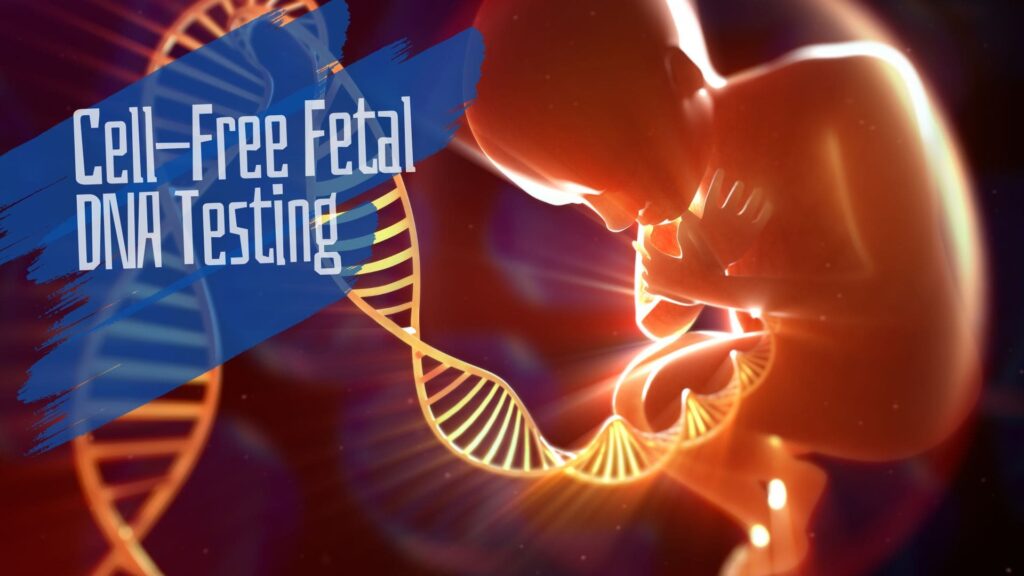“A cell-free fetal DNA test is a specialized Non-invasive prenatal genetic test used for the screening of genetic conditions associated with a fetus. Learn about various aspects of a cell-free fetal DNA test in this article.”
For every woman, in fact, for every parent, pregnancy is a joyful time. It’s an amazing feeling. However, it comes with a shared concern of developing fetus. Parents have to worry a bit about the health status of the developing fetus.
This becomes even more crucial for parents having any kind of medical conditions or genetic history. The pregnancy and post-pregnancy time becomes a nightmare for them, otherwise.
Advancement in medical science has opened new doors for prenatal screening and testing. Now, parents can go for fetal screening/testing and make a decision on their pregnancy.
One such technique is cell-free fetal DNA testing– a type of NIPT (non-invasive prenatal (genetic) testing). In this article, I will explain to you the concept of the present technique.
I will also explain the test process, why and when to go for it. I will further list the benefits and limitations as well. I worked in a prenatal genetic testing lab and trust me I handled thousands of prenatal samples including AF, CVS and a few cfDNA.
So at Genetic Education Inc. I will guide you to this futuristic and revolutionary technique- cell-free fetal DNA testing.
Stay tuned.
Disclaimer: The present article is written for information purposes. The sole aim is to educate students. Concern your doctor before making a decision based on the present article.
Key Topics:
What is cell-free fetal DNA?
Now before moving ahead, we have to understand the concept of cell-free fetal DNA. What exactly is it? Put simply, It’s a freely floating fetal DNA in a maternal bloodstream.
The cell-free fetal DNA is also known as cffDNA in short. It originates from the fetal placenta. The placenta is temporarily formed between the maternal and fetal tissue. It helps transport nutrients and oxygen to the fetus.
The fetus undergoes various developmental processes by cell division. In this process, new cells are formed and die, continuously and cell-free are released. Note that cell-free DNAs are the fragments released during the cell death process.
As the placenta connects the fetus with a mother, the free DNA will be directly released into the maternal bloodstream. The placenta works as a barrier or filter and disallows dead cell transport, however, DNA fragments can pass the barrier and enter into maternal blood.
Now, the fetal cell-free DNA fragments circulate into the maternal blood and are readily available for testing. Scientists collect the fetal DNA fragments from the maternal blood and perform DNA tests.
This is a broad concept of cell-free fetal DNA. Now, we will understand cell-free fetal DNA testing– how it’s done!
What is Cell-Free Fetal DNA Testing? How It’s Done?
Cell-free fetal DNA testing is a non-invasive DNA test used for the screening and/or detection of genetic abnormalities associated with the fetus. It’s a prenatal genetic test, used for the early detection of any genetic condition associated with the developing fetus.
In 1997, Lo YM, Tsui NB and Chiu RW demonstrated and developed a cell-free DNA testing technique.
It can detect chromosomal abnormalities (like Down syndrome or microdeletions) and a few types of monogenic disorders. In the testing process, maternal blood is collected, cell-free fetal DNA is isolated and detected using techniques like PCR, DNA sequencing or microarray.
Procedure:
Sample collection:
10 to 15 ml of blood is collected from the mother. The cffDNA are smaller fragments than the nuclear DNA, thus, to avoid the maternal nuclear DNA, centrifuge the sample and remove the pellets.
The serum containing the cffDNA is collected into a new sterile tube and processed for DNA extraction. A standard blood collection procedure has been followed to collect the sample. Also, keep in note that the serum should be sent for DNA extraction, immediately.
DNA extraction:
Unlike DNA extraction from other samples or tissues, cffDNA extraction is a bit complicated and difficult process. As we are dealing with a very minute amount of DNA fragments, alcohol precipitation as well as other conventional and manual protocols perhaps can’t work here.
Standard (ready-to-use) kits for cffDNA isolation are now available and are the only option here. Use any of the available kits to extract cffDNA from the maternal blood. Store the DNA at 4ºC temperature.
Quantify the cffDNA before downstream processing.
Fragment library preparation:
Now, understand that the DNA, what we have, is not the complete genome, but only the fragments. However, to make it usable, the cffDNA is fragmented into smaller fragments for better analysis.
Numerous techniques are available for DNA fragmentation and library preparation. In addition, an optional library preparation step is performed for DNA sequencing purposes to enrich the cffDNA.
Related article: DNA Fragmentation: Techniques, Importance and Applications.
Genetic analysis:
Depending on the requirement or screening purpose, the genetic testing technique is selected for downstream analysis. Usually, DNA sequencing (like the NGS) is selected for high throughput, accurate and precise testing.
Results and report:
After completion of testing, results are evaluated by an expert geneticist and a test report is prepared. The report is handed over to the patient by a genetic counselor who helps them understand the test, report and condition, if any.
When to go for a cffDNA test?
cffDNA test is a costly and specialized genetic test, so it’s important for patients to understand when to go for the test. Here are some of the suggestions for patients.
- Those having a prior or previous history of any genetic or chromosomal abnormality or any history of genetic conditions in their family.
- Women over the age of 35 have higher chances of fetal genetic abnormalities. Over-age women planning for pregnancy should consider a cffDNA test.
- Indications by ultrasound or blood test, if suggest any fetal complication.
It’s important to note that prior doctor’s advice is required before going for a cffDNA test.
When to not go for a cffDNA test?
cffDNA test is a specialized genetic test as I said above. So it isn’t required for every pregnant woman. It isn’t required for normal-age pregnancies (between 25 to 30 years of age), twin pregnancies and no family history of any genetic disease.
Also, it’s not recommended for patients with hemophilic conditions and pregnancies less than 10 weeks.
Why is the cffDNA test required?
Now, anyone may have a question, why do we need to go for a cffDNA test?
There are two reasons for that. First, in the present time, genetic disorders are increasing at a rapid pace. Early pregnancy genetic testing helps in not only prevention but also in reducing the disease burden on the population.
The second is safety.
The traditional amniocentesis for either amniotic fluid collection or chorionic villi sample collection is a painful process that may infect the sample collection site, and produce complications for the fetus.
In the case of hemophilic patients, it can create even serious complications related to bleeding. Contrary, cffDNA testing is non-invasive, safe and simple. We just need a few ml of blood from the mother and that’s it.
No need to deal with the fetus.
Related article: How to Process CVS (Chorionic Villi) Sample for Prenatal Testing?
Benefits:
Early detection:
The main advantage of cell-free fetal DNA testing is early fetal screening. The fetus can be screened for genetic conditions like Down or Patau syndrome as early as the first trimester. Parents can get information regarding the health of developing fetus early during pregnancy.
Less chances of fetal loss:
Amniocentesis is prone to fetal loss or miscarriage. The present technique is safer in this context.
Non-invasive:
As we aforesaid, the technique is non-invasive and safer for the fetus. No complications are involved in the sample collection as well as testing.
Accuracy:
The present technique more accurately detects various genetic diseases and conditions. It comes with a very low false-positive rate, especially for chromosomal alterations.
Peace of mind:
The invasive sample collection like amniocentesis is a stressful condition for the mother. In addition, parents also feel anxiety related to their unborn child. Early detection using cffDNA testing gives relief to parents. With negative results, parents especially the mother feel relaxed and focus on improving her pregnancy only.
Help in decision-making:
One of the biggest advantages of cffDNA testing is that it helps in making informed decisions. If anything goes wrong with the pregnancy, parents have time and reason to make a decision, whether to continue or not. However, the decision would entirely remain reserved to the parents.
Limitations:
Along with the lucrative benefits, cffDNA testing also has several limitations too.
- Keep in mind that the cell-free fetal DNA test is not a diagnostic test, it’s a screening test. Meaning, it can’t accurately tell about the fetal abnormality. Further tests like amniocentesis are needed to validate the results.
- Right now, fewer standardized protocols and assays are available and therefore it’s a costly technique. Cost is a major factor for parents as well as medical practitioners.
- In addition, it has limited scope. After all, those are just fragments of DNA, not the genome. Meaning, that it can’t get all the DNA and thus, can’t perform all types of DNA tests.
- For example, suppose we want to study a P53 gene, but the fragment or chromosomal part containing the P53 gene isn’t present in the cffDNA. Then, We can’t conduct screening in that case.
- However, standard protocols for a few types of chromosomal and genetic abnormalities are now available and routinely performed in some laboratories.
- It can’t detect rare chromosomal and genetic abnormalities.
- cffDNA collection is one of the tedious processes. Retrieving highly pure DNA needs a standard protocol/kit or expertise.
- The present technique is also prone to false-positive and false-negative results.
- Contamination of maternal DNA also creates additional difficulties in the analysis process.
- Besides all these, the biggest limitation of cffDNA testing is that it isn’t available for twin pregnancies. It is very difficult to distinguish cffDNA from the twins.
Related article: How to Remove Maternal Cell Contamination In Prenatal Genetic Testing?
What do the results of the cffDNA test indicate?
cffDNA test results are just like the results of other DNA tests. It indicates whether or not, the fetus is suffering from any chromosomal or genetic abnormality. However, it has limited scope.
Wrapping up:
Cell-free fetal DNA is an amazing non-invasive prenatal testing option. Unfortunately, it isn’t fully available right now! A few laboratories are offering such testing but have fewer testing strengths and accuracy.
Nonetheless, the present testing technique will change the fate of prenatal testing in the near future, for sure. Till then, we need more research, more optimized protocols and standard procedures to deal with the cell-free fetal DNA.
Sources:
Rafi, I., & Chitty, L. (2009). Cell-free fetal DNA and non-invasive prenatal diagnosis. The British journal of general practice : the journal of the Royal College of General Practitioners, 59(562), e146–e148. https://doi.org/10.3399/bjgp09X420572.
Wang, Jw., Lyu, Yn., Qiao, B. et al. Cell-free fetal DNA testing and its correlation with prenatal indications. BMC Pregnancy Childbirth 21, 585 (2021). https://doi.org/10.1186/s12884-021-04044-5.
Subscribe to our weekly newsletter for the latest blogs, articles and updates, and never miss the latest product or an exclusive offer.



